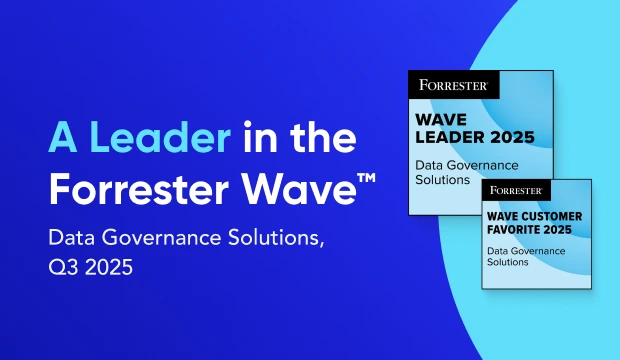Data Governance Basics: Everything You Need to Know in 2024

Share this article
The basics of data governance refer to the foundational principles and practices that ensure the quality, consistency, security, and appropriate use of an organization’s data.
In today’s data-centric world, managing data effectively is essential to the success of any organization. It’s not just about collecting and storing data; it’s about ensuring that the data is accurate, secure, and readily available to those who need it.
Modern data problems require modern solutions - Try Atlan, the data catalog of choice for forward-looking data teams! 👉 Book your demo today
As we all know, data governance can be a complex topic with many nuances to consider. That’s why we’ve put together this article to help you navigate the basics of data governance in an easily digestible manner.
Let’s dive in!
Table of contents #
- What is data governance? Understanding the basics
- Data governance basics: Learning the framework
- Understanding the basic process of data governance
- 7 Must-read books for understanding the basics of data governance
- Let’s recap!
- Data governance basics: Related reads
What is data governance? Understanding the basics #
Let’s start with the first basic concept of data governance, which is “What is data governance?”
Data governance is a set of processes, policies, and standards that ensure the proper management, usage, and protection of an organization’s data assets. It aims to maintain data quality, security, and compliance while enabling seamless integration and accessibility of data across the organization.
And, there are some essential framework of data governance that you need to be aware of. Let’s take a look at them in this article.
Data governance basics: Learning the framework #
Data governance is a set of practices and policies that ensures high data quality, management, and security within an organization. It involves the management and protection of data, ensuring reliability, consistency, and accuracy throughout the organizational processes. Here’s a detailed explanation based on the basic framework of data governance :
1. Strategy and objectives #
- Alignment: Ensure that data governance aligns with organizational objectives and strategy.
- Value: Understand and articulate the business value that data governance will bring.
- Roadmap: Develop a roadmap that outlines the steps and milestones toward achieving data governance goals.
2. Data stewardship and ownership #
- Data stewards: Identify and assign individuals or teams who will be responsible for data quality, management, and policies enforcement.
- Ownership: Ensure that data ownership is clear and understood across various domains and business units.
3. Data policies and standards #
- Data policies: Develop policies outlining how data should be handled, stored, and shared.
- Data standards: Establish standards and guidelines that ensure data consistency and accuracy across the organization.
4. Data quality #
- Accuracy: Ensure data is accurate, valid, and reliable.
- Consistency: Maintain data consistency across various platforms and business units.
- Completeness: Verify that all necessary data is fully captured and documented.
5. Data privacy and security #
- Access control: Implement controls on who can access data and under what circumstances.
- Compliance: Ensure that data handling, storage, and processing complies with relevant laws and regulations, such as GDPR or CCPA.
- Data protection: Implement measures to secure data against unauthorized access and data breaches.
6. Data architecture #
- Data modeling: Define how data is organized and how relationships among data entities are handled.
- Integration: Ensure that data is integrated and can flow between different systems and platforms effectively.
- Metadata management: Manage data about data to ensure it’s easy to locate and understand.
7. Data lifecycle management #
- Creation and acquisition: Managing data right from creation or acquisition.
- Usage: Monitor how data is used and by whom.
- Archiving and disposal: Implement policies for data retention, archiving, and lawful disposal.
8. Technology and tools #
- Data management tools: Implement tools for data quality management, metadata management, and data integration.
- Security tools: Utilize technology that ensures data security, like encryption and firewall.
- Analytics tools: Employ tools and platforms that facilitate data analytics and business intelligence.
9. Data monitoring and auditing #
- Monitoring: Constantly supervise data quality and adherence to policies and standards.
- Auditing: Periodically check and ensure that data governance policies are being followed and assess the quality of the data.
10. Communication and training #
- Communication: Regularly communicate about data governance policies, updates, and best practices across the organization.
- Training: Provide training to ensure that all staff understand their roles and responsibilities within the data governance framework.
An effective data governance framework ensures that data throughout the organization is accurate, available, and secure.
Understanding the basic process of data governance #
Understanding the basic process of data governance involves delving into the step-by-step progression through which an organization manages and utilizes its data. The aim is to ensure data’s reliability, consistency, accessibility, and security. Here’s a detailed view of the basic process of data governance:
1. Define data governance objectives #
- Strategic alignment: Determine how data governance will align with and support the organization’s overall strategy.
- Objective setting: Define clear, measurable objectives for the data governance initiative, such as improving data quality, ensuring compliance, or enhancing decision-making.
2. Establish data governance structure #
- Framework setup: Adopt a structured framework that includes policies, standards, and practices related to data management and usage.
- Roles and responsibilities: Define and assign roles like data owners, stewards, and custodians, ensuring clear accountability and responsibility.
3. Develop policies and standards #
- Policy development: Formulate policies regarding data management, usage, quality, security, and privacy.
- Standardization: Establish standards for data to ensure consistency, accuracy, and reliability across the organization.
4. Implement data governance initiatives #
- Initiative launch: Begin data governance initiatives in alignment with the defined objectives and adhering to the formulated policies.
- Technology and tools: Leverage appropriate technologies and tools for data management, security, and analytics.
5. Manage data quality #
- Data profiling: Understand the current state of data through profiling and assessment.
- Data cleansing: Identify and correct (or remove) errors and inconsistencies in data to improve its accuracy.
- Quality maintenance: Establish processes to maintain data quality throughout its lifecycle.
6. Ensure data security and compliance #
- Security implementation: Adopt security measures like encryption, access controls, and audit trails to safeguard data.
- Compliance monitoring: Ensure data practices comply with relevant regulatory requirements like GDPR, HIPAA, etc.
7. Define and manage data architecture #
- Data modeling: Establish data models that define how data is stored, accessed, and managed.
- Metadata management: Implement a system to manage metadata, ensuring data is understandable and usable.
8. Monitor and audit data usage #
- Usage monitoring: Keep tabs on how, when, and by whom data is accessed and utilized.
- Auditing: Periodically audit data processes and usage to ensure alignment with policies and standards.
9. Training and communication #
- Staff training: Conduct training programs to ensure that staff is well-versed in data governance policies and practices.
- Communication: Ensure constant communication about data governance activities, achievements, and changes.
10. Review and improve #
- Performance review: Assess the effectiveness of data governance initiatives against the set objectives.
- Continuous improvement: Identify areas for improvement and refine policies, practices, and initiatives accordingly.
Data governance is a cyclical and continuous process that evolves with an organization’s needs and the data landscape.
From the initial setting of objectives through to the continuous review and improvement of processes, effective data governance ensures that data is a reliable, secure, and valuable asset in driving organizational success.
7 Must-read books for understanding the basics of data governance #
The following books will help you gain an in-depth understanding of data governance, and equip you with the requisite knowledge.
-
“Data Governance: How to Design, Deploy and Sustain an Effective Data Governance Program” by John Ladley 👉 This book provides a comprehensive guide to designing, implementing, and sustaining a data governance program.
-
“The Data Governance Imperative” by Steve Sarsfield 👉 This book discusses the importance of data governance and offers practical advice for implementing a successful data governance program.
-
“Data Management for Researchers: Organize, maintain and share your data for research success” by Kristin Briney 👉 This book covers various aspects of data management, including data governance, and is specifically geared towards researchers.
-
“The DAMA Guide to the Data Management Body of Knowledge” (DAMA-DMBOK) by DAMA International 👉 This comprehensive guide covers all aspects of data management, including data governance, and is an excellent resource for professionals in the field. (Read our article on What is DAMA-DMBOK Framework and How to Adopt It.)
-
“Non-Invasive Data Governance: The Path of Least Resistance and Greatest Success” by Robert S. Seiner 👉 This book introduces the concept of non-invasive data governance, which focuses on formalizing existing data governance practices rather than implementing new, disruptive processes.
-
“Data Governance: Creating Value from Information Assets” by Neera Bhansali 👉 This book provides an overview of data governance concepts and offers practical guidance for implementing a data governance program in your organization.
-
“Data Strategy: How to Profit from a World of Big Data, Analytics and the Internet of Things” by Bernard Marr 👉 While not exclusively focused on data governance, this book discusses the strategic importance of data management and governance in the context of big data and analytics.
These books cover various aspects of data governance, from conceptual understanding to practical implementation. By reading these data governance books, you can develop a solid foundation in data governance and better understand its importance in your organization.
Let us now recap what we have learned so far.
Let’s recap! #
5 key points to keep in mind as we wrap up this article:
- Data governance is a set of processes, policies, and standards that ensure the proper management, usage, and protection of an organization’s data assets.
- Key objectives of data governance include improving data quality, ensuring data privacy and security, establishing data standards, streamlining data management, and enhancing data-driven decision-making.
- Important aspects of data governance include the data governance framework, data stewardship, data quality, metadata management, data lineage, data cataloging, data privacy and security, and data integration.
- A basic thinking framework for the key aspects of data governance involves:
- Data Governance Framework 👉 Defining purpose, roles, policies, processes, standards, tools, and metrics.
- Data Quality 👉 Understanding dimensions, creating validation rules, implementing cleansing, monitoring, and continuous improvement.
- Data Stewardship 👉 Defining roles, encouraging collaboration, providing training, setting up issue resolution processes, and facilitating communication.
- Data Privacy and Security 👉 Understanding regulations, classifying data, implementing access controls, using data masking and encryption, and managing incidents.
- Books to help you understand the basics of data governance. Such as “Data Governance” by John Ladley, “The Data Governance Imperative” by Steve Sarsfield, and “The DAMA Guide to the Data Management Body of Knowledge” (DAMA-DMBOK) by DAMA International.
By understanding and implementing data governance principles, your organization can effectively manage its data assets, ensure data quality and compliance, break down data silos, and support data-driven decision-making. And that’s all.
Data governance basics: Related reads #
- Data Governance 101: Principles, Examples, Strategy & Programs
- Data Governance Policy — Examples & Templates
- Data Governance Framework — Guide, Examples, Template
- Data Governance and Compliance: Act of Checks & Balances
- 7 Best Practices for Data Governance to Follow in 2024
- Data Governance Roles and Responsibilities: A Quick Round-Up
Share this article











